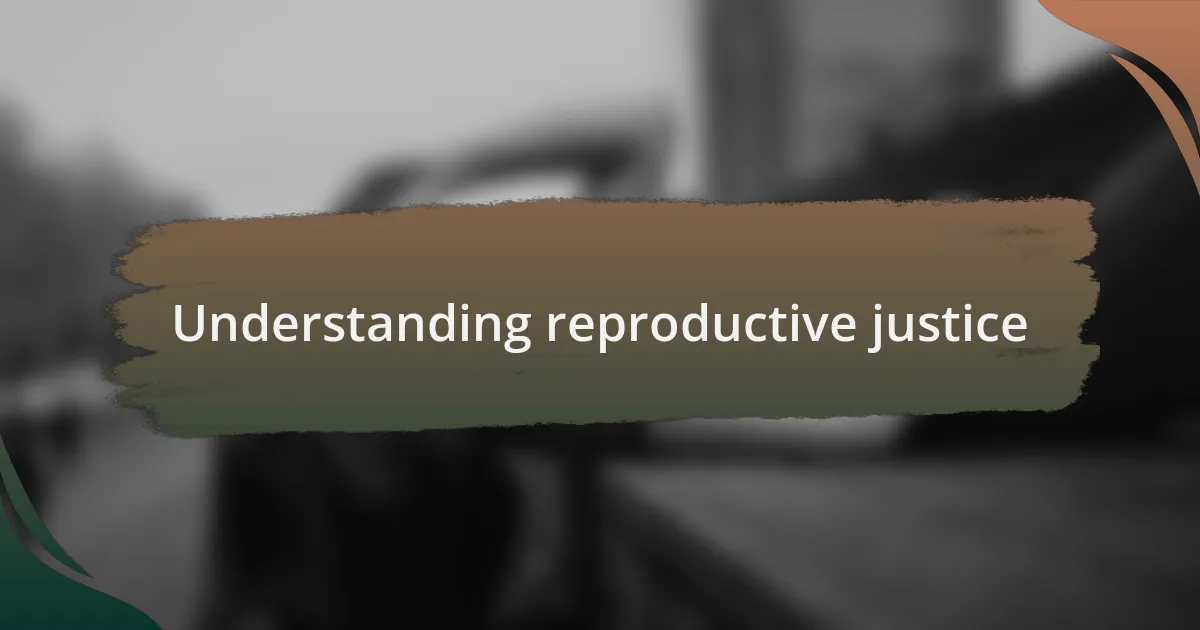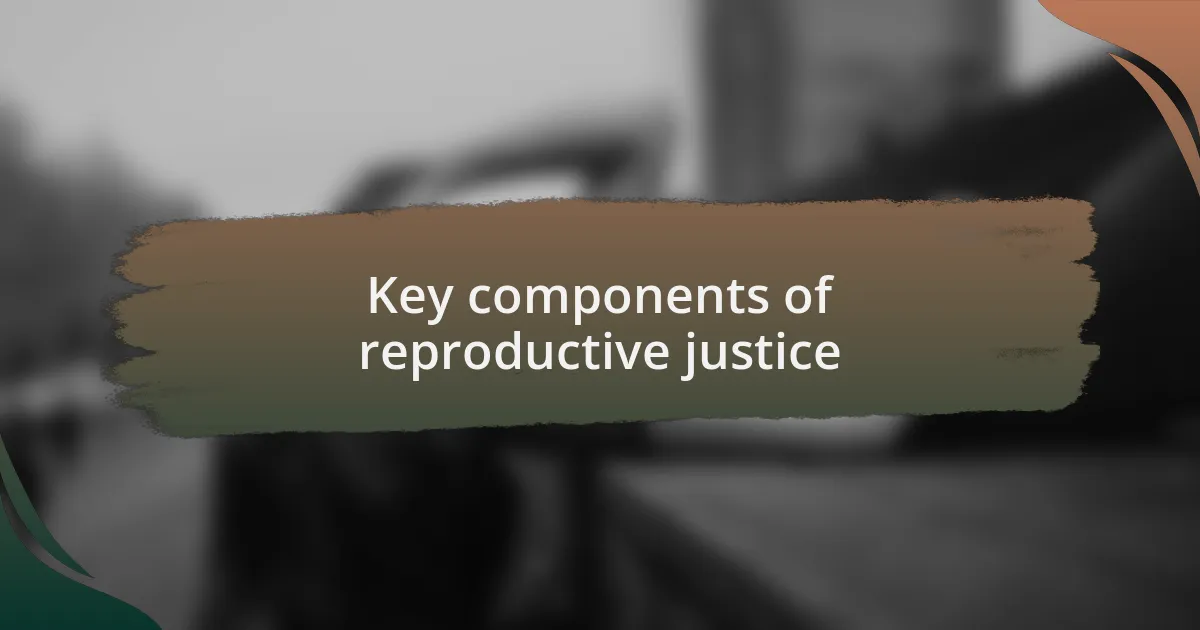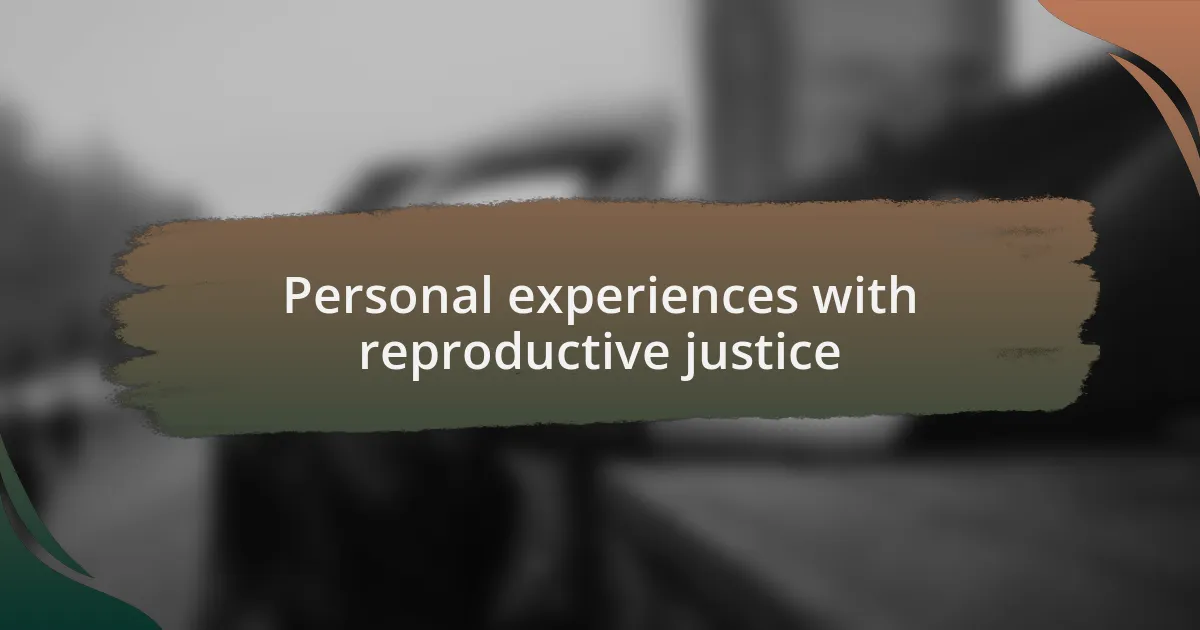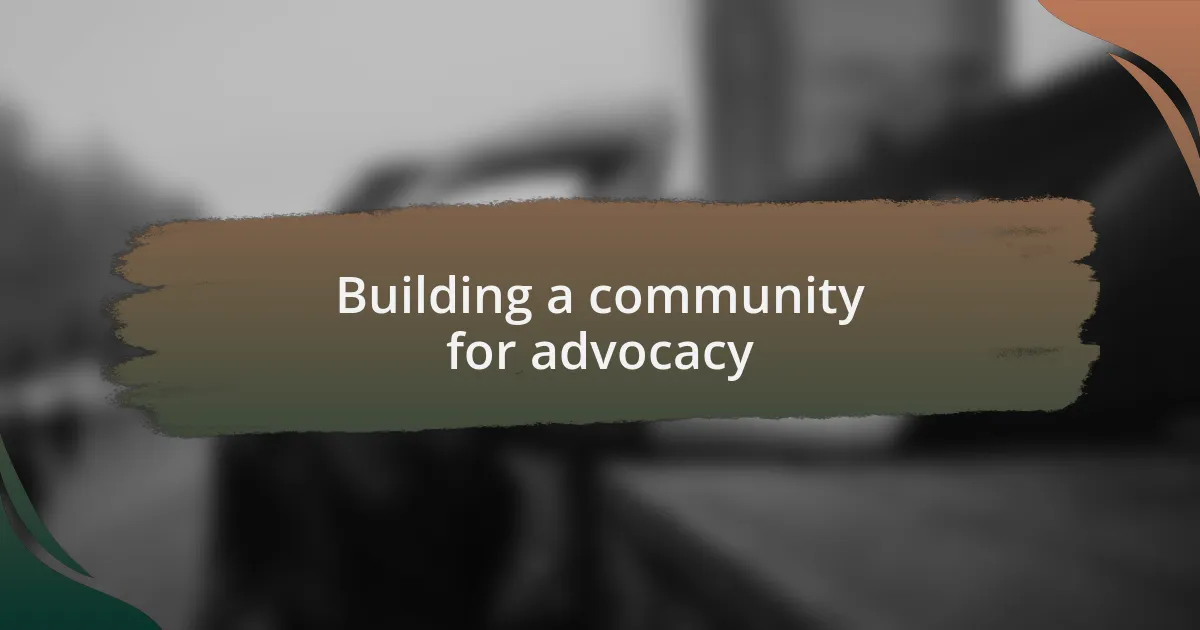Key takeaways:
- Reproductive justice is interconnected with social, economic, and environmental justice, emphasizing the importance of community well-being in accessing reproductive health services.
- The key components of reproductive justice include the right to have children, not have children, and to parent in safe environments, highlighting the necessity of addressing barriers in healthcare access.
- Personal experiences and storytelling play a crucial role in fostering empathy and solidarity within communities, driving advocacy for reproductive rights.
- Building strong advocacy networks is essential for creating impactful change, as collective efforts amplify individual voices and drive systemic reforms in reproductive health policies.

Understanding reproductive justice
Reproductive justice is a concept that extends beyond mere access to reproductive health services. It intertwines the issues of social, economic, and environmental justice, emphasizing that our reproductive rights are deeply connected to the well-being of our communities. I often reflect on how societal factors, like poverty and discrimination, can create barriers for individuals seeking these essential services—have you ever considered how someone’s zip code can determine their access to care?
When I think about reproductive justice, I can’t help but remember the story of a friend who faced unimaginable hurdles while trying to seek medical care. She shared how the stigma around her situation led to isolation and fear, making it even more difficult to navigate her choices. This experience illuminated for me how emotional and psychological supports are often overlooked; reproductive justice isn’t just about the right to choose but also about the right to be supported and heard in our choices.
Moreover, I’ve often questioned why the narrative around reproductive health feels so fragmented. Isn’t it vital that we understand how race, class, and gender identity intersect in these discussions? I believe that true reproductive justice means fostering a safe space where every individual — regardless of their background — can control their reproductive lives without judgment or barriers. This holistic understanding is crucial if we want to advocate effectively for the rights and health of all women.
Importance of women’s health
Women’s health is foundational to the overall well-being of society. I have witnessed firsthand how access to proper healthcare empowers women to make informed decisions about their bodies and families. Have you ever noticed how a simple conversation about health can foster deeper connections and understanding within communities?
From my perspective, ensuring that women receive comprehensive healthcare leads to healthier families and stronger communities. I recall a community health event where I engaged with mothers who shared their challenges in navigating the healthcare system. Their stories highlighted the significant gaps that exist and reminded me that when women’s health needs are prioritized, everyone benefits.
It’s clear to me that women’s health disparities aren’t just statistics; they reflect the lived realities of individuals grappling with systemic inequities. I often find myself considering how many lives could be transformed with better access to reproductive healthcare. Isn’t it time we advocate passionately for a future where women’s health is treated as a fundamental right, not a privilege?

Key components of reproductive justice
When I think about the key components of reproductive justice, three elements immediately come to mind: the right to have children, the right to not have children, and the right to parent children in safe and supportive environments. These components are deeply intertwined and reflect the holistic nature of reproductive justice. For instance, I remember attending a workshop where participants discussed the struggles many face in accessing family planning services. It was eye-opening to see how the lack of resources leads to a cycle of inequity, affecting generations.
Access to healthcare is another critical component. It’s not just about availability; it’s about eliminating barriers—whether they are financial, geographical, or societal. I can personally relate to a friend who faced countless obstacles when trying to get prenatal care. Her experience reinforced my belief that when we address these barriers, we empower women to take control of their reproductive choices. Have you considered how access impacts not only individual lives, but entire communities?
Finally, the intersection of social justice and reproductive rights cannot be overlooked. Factors like race, socio-economic status, and environment play a significant role in shaping women’s experiences. I often reflect on the conversations I’ve had with activists who emphasize the importance of equity in reproductive healthcare. I’ve learned that when we advocate for reproductive justice, we’re not just supporting individual rights; we’re championing a movement that recognizes the diverse needs of all women. Isn’t it vital that we approach reproductive health through this inclusive lens?

Advocacy strategies for reproductive rights
Advocacy strategies for reproductive rights must include grassroots mobilization, as it’s crucial to connect with communities on a personal level. I recall attending a community event organized by local activists aimed at raising awareness about reproductive rights. The energy in the room was palpable, as attendees shared their stories and emphasized the importance of personal narratives in driving change. Hasn’t personal experience always been a powerful tool for connection?
Engaging in policy advocacy is another essential strategy for protecting reproductive rights. I’ve seen firsthand how reaching out to local representatives can lead to tangible changes in legislation. In one instance, my friends and I wrote letters to our state lawmakers advocating for expanded access to contraceptive services. It was inspiring to see how, collectively, our voices could influence policy outcomes. Isn’t it amazing how a simple act can ripple out to create a larger impact?
Additionally, leveraging social media as an advocacy tool has proven invaluable in spreading awareness about reproductive rights. I’ve witnessed the power of viral campaigns that mobilize hundreds of supporters, often igniting conversations that challenge societal norms. When I participated in a hashtag campaign, I realized that digital platforms allow us to amplify marginalized voices in a way that traditional methods struggle to achieve. How about thinking of social media not just as a tool but as a community-building platform?

Personal experiences with reproductive justice
Navigating personal experiences with reproductive justice has profoundly shaped my understanding. I remember a time when a close friend confided in me about her struggle to access necessary reproductive healthcare. Listening to her recount the obstacles she faced underscored the reality that for many, these issues are not just political—they’re deeply personal and often terrifying. They challenge us to consider: How would we respond if faced with such barriers ourselves?
On a different occasion, I participated in a local reproductive rights event that encouraged sharing stories. I decided to speak about my own journey with contraception and the societal pressures surrounding it. The support and empathy in the room were palpable, and it reinforced my belief that when we share our truths, we create a network of solidarity. Isn’t it incredible how vulnerability can transform a simple gathering into a powerful call for justice?
Reflecting on my own experiences, I’ve found that reproductive justice extends beyond legal rights; it intertwines with our emotional and mental well-being. In a particularly challenging moment, I realized that the stigma surrounding discussions of reproductive health creates additional layers of stress. This revelation pushed me to advocate for open conversations, allowing others to express their fears and triumphs. How can we foster an environment where everyone feels safe to share their stories?

Ways to support reproductive health
One way to support reproductive health is by volunteering at local clinics or organizations that provide essential services. I recall my first day volunteering at a women’s health center; I was struck by the dedication of the staff and the diverse range of women seeking care. It truly highlighted the impact of grassroots efforts on the health and well-being of our communities.
Another approach is to engage in conversations about reproductive health with friends and family. I often find that discussing my experiences with contraception choices opens the door to deeper dialogue. Have you ever noticed how just sharing your story can lead others to reflect on their own? This kind of openness can demystify the topic and reduce stigma.
Additionally, advocating for policies that prioritize reproductive rights is crucial. I often reach out to my local representatives to express the importance of accessible reproductive health services. It’s a small step, but every voice matters in shaping a collective future where everyone’s health is prioritized. How often do we take a moment to remind our lawmakers that these issues affect real lives?

Building a community for advocacy
Building a community for advocacy is essential to creating a strong support system for reproductive justice. I remember attending a local rally where individuals from all walks of life gathered, united by a shared purpose. The energy was palpable—each person brought their own stories and struggles, reminding me that our collective voice has the power to confront and dismantle systemic barriers.
Joining hands with others who share a commitment to this cause can amplify our impact. I found myself part of a book club focused on reading and discussing works by authors addressing reproductive issues. Those discussions sparked not just conversations, but friendships. Have you ever experienced that moment when a casual gathering transforms into a movement? It’s incredible how shared knowledge fosters solidarity and drives action among community members.
Ultimately, building relationships within our advocacy networks can lead to more robust and sustainable efforts. I’ve seen how regular meetings among local advocacy groups create platforms for sharing resources and strategies. Isn’t it inspiring to think that together, we can create campaigns that change perceptions and policies? Through these connections, we weave a fabric of support that strengthens our resolve and empowers each individual voice.